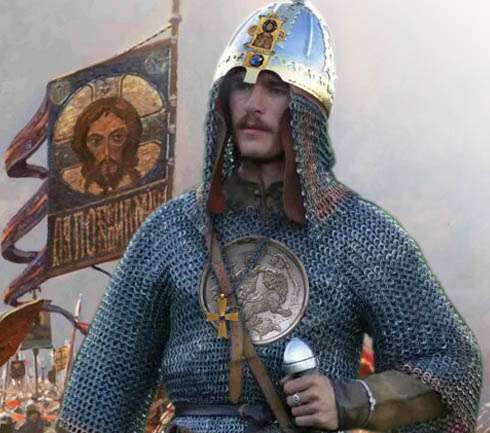It’s Monday, December 15, 2025 in Austin, Texas
Is Nick Long Jr. Fred Astaire's Younger Brother?
Meet the forgotten dancing star of Broadway Melody of 1936. His story ends in an unmarked grave in Cypress Hills Cemetery in Brooklyn New York. Was his death at 43 a suicide?
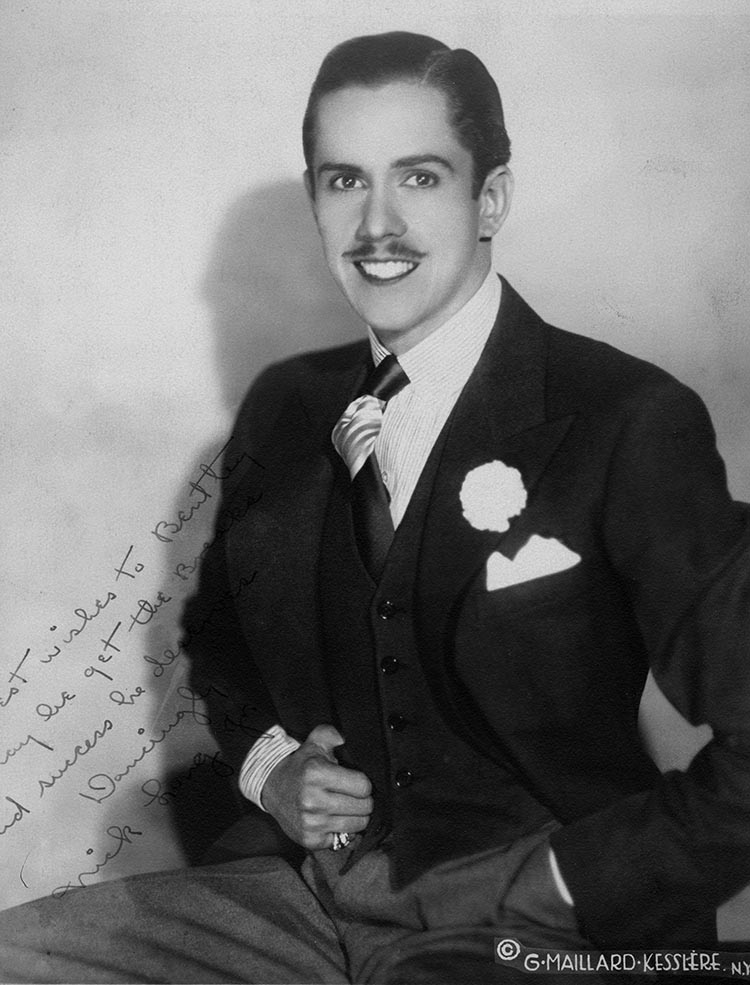 A couple of years ago I saw Broadway Melody of 1936 on TCM - Turner Classic Movies. I didn't remember having seen it before, even though I have always been a fan of Busby Berkeley-style productions like this.
A couple of years ago I saw Broadway Melody of 1936 on TCM - Turner Classic Movies. I didn't remember having seen it before, even though I have always been a fan of Busby Berkeley-style productions like this.
There was a dancer named Nick Long Jr. in the film I had never seen or heard of before. I did a search on the web, but I couldn't find very much on him. He did two movies in Hollywood at the same time, the other being The King of Burlesque. You couldn't miss Nick in Broadway Melody, he had two long dance sequences with June Knight. One was I Got a Feeling You're Fooling and the other was Broadway Rhythm. Nick was a lyrical partner in the style of Fred Astaire, but he was best known as an aerobatic dancer who did stunts like leaping over seven women or flying off the stage in breathtaking jumps. He was known as the inventor of "Furniture Dancing", which was later imitated by Astaire and Gene Kelly. After I saw him I wondered what else he had done and why I had never heard of him before. He and Astaire had physical similarities; both were thin and lithe and Astaire had runtish facial features like Nick. Compared to co-stars like Robert Stack neither Astaire were good-looking. Both Nick and Fred had high squeaky voices. Despite these drawbacks, donning a top coat and tales did amazing things for both dancers. Fred Astaire and his sister Adele had been a very successful team on Broadway before he headed to Hollywood. Nick would follow the same path.
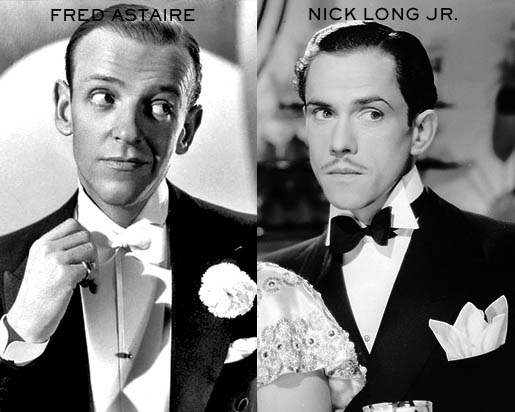 So why did Astaire go on to be a huge Hollywood star and Nick Long Jr. virtually vanish from dance history and the movies? I think one answer was Astaire had a great choreographer, Hermes Pan, who knew how to make Astaire and Ginger Rogers look great on stage. Nick did his own choreography, which was a mistake, since it didn't push Nick to dance beyond his own physical limitations.
So why did Astaire go on to be a huge Hollywood star and Nick Long Jr. virtually vanish from dance history and the movies? I think one answer was Astaire had a great choreographer, Hermes Pan, who knew how to make Astaire and Ginger Rogers look great on stage. Nick did his own choreography, which was a mistake, since it didn't push Nick to dance beyond his own physical limitations.
Pan was the creator of the effortless, sophisticated and romantic routines that made Fred and Ginger famous. He was a creative genius and Astaire called him his "ideas man". Pan was a dancer, too, and he was Astaire's rehearsal partner and Ginger's stand-in. Like Nick Hermes Pan spent a large part of his youth on the streets of New York and launched his career there. Also, like Nick Pan never married and it was well known in the movie industry that Pan was gay. He was very religious and kept his sexuality totally concealed. Fred Astaire was married twice and had kids, but Gore Vidal claims to have had an affair with him. Perhaps this explains the special bond between him and Pan. Nick never had a Hermes Pan to help him create an on-stage persona, perfect his technique and grow as an artist. Pan was a gentle, kind and patient man who was well-liked by everyone. He was loyal to his friends. Unlike an talent agent who was only in it for the money and would disappear when his fees dried up, Pan stuck with you through good and bad times. Like the best of coaches he was happiest when a dancer perfected the routines he created and then rehearsed them in. Sometimes, like with Astaire, he had a true partnership of give and take during the creative process.
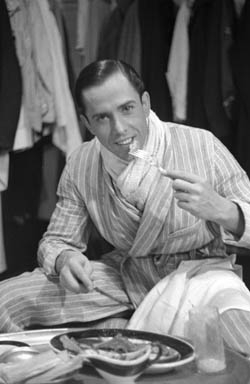 To return to Nick Long, Jr. - I began my hunt for him in 2012 - I searched online, but there wasn't much to be found. I found his birth date and his death in 1949 in a car accident on the way back from a performance on the IMDB. There were a few pictures and a bunch of references to his work with Danny Kaye in the 30's in New York and London.
To return to Nick Long, Jr. - I began my hunt for him in 2012 - I searched online, but there wasn't much to be found. I found his birth date and his death in 1949 in a car accident on the way back from a performance on the IMDB. There were a few pictures and a bunch of references to his work with Danny Kaye in the 30's in New York and London.
I decided to use Ancestry.com to try and construct a timeline of his life and work. This timeline has a ton of stuff on it that I found. The research was tedious, but almost like a treasure hunt for me. I would find references to Nick's life hidden all over the web in reviews, articles and ads for his performances. I also used the huge database of Variety on my.heritage.com. Once I got his tree started I was able to find his parents and I added as much information as I could find on them, too. His mom and dad, Nick Long Sr. and Idalene Cotton, were both actors born in San Francisco. Nick Sr.'s parents were Italian immigrants, they ran a store in San Francisco. Nick Sr. was born in 1855 and Idalene was born 19 years later in 1874. I started with basic stuff on them and then filled out their ancestry profiles with as many dates of performances I could find. I learned a lot about their whole family through this process. As I found more and more about them their lives just opened up before me. The ancient Egyptians said when you spoke the names of the dead they came to life - that's how I felt as I met Nick and the rest of the Cotton-Longs in my research - I was bringing them back to life.
I had no idea when I started my search that I would end up learning so much. Each event or fact I find leads to another discovery. I would have to admit it has become something of an obsession for me. I start in one direction and then land somewhere entirely different and unexpected. Ultimately it ends in a sad and lonely tragedy.
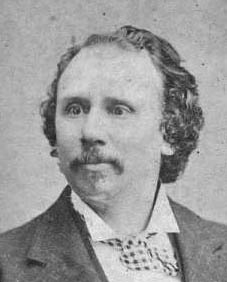 Idalene's dad was the famous minstrel performer and show producer, Ben Cotton (you can see him on the right), who toured all over the USA and Europe from the middle of 1800's until his death in 1908. Hewas a member of the Cotton and Cooley minstrel act with touring the USA and Europe. He died after a long illness in his home on 146th Street in New York, Idalene and Nick Sr. were with him. Virtually the entire Cotton family was involved in minstrels at one time or another. Ben had two wives. There is a mystery about the first one. There is no record of the marriage or a divorce. His second wife, Ellen Francis, called "Nellie" was a dancer. The minstrel show, or minstrelsy, was an American form of entertainment developed in the 19th century. It was a form of entertainment that required payment to attend and involved comic acts, music and dancing performed by white people wearing black-face make-up. Ben and his minstrel troops of actors traveled the world. They became a global sensation. However, he was not a good businessman. He made and lost a fortune in the minstrel business. He traveled at least twice to Europe and may have brought both of his kids. Ben Cotton was part owner of the famous Alcazar Theater in San Francisco and at that time he was worth $10,000, which was a lot of money in 19th century America. Ben tried to escape his success as a minstrel playing other parts, but the public would not accept him as anything else and he had to return to black-face time and again in his long career. His wife - Idalene's mother - died in 1894 in a home for incurables.
Idalene's dad was the famous minstrel performer and show producer, Ben Cotton (you can see him on the right), who toured all over the USA and Europe from the middle of 1800's until his death in 1908. Hewas a member of the Cotton and Cooley minstrel act with touring the USA and Europe. He died after a long illness in his home on 146th Street in New York, Idalene and Nick Sr. were with him. Virtually the entire Cotton family was involved in minstrels at one time or another. Ben had two wives. There is a mystery about the first one. There is no record of the marriage or a divorce. His second wife, Ellen Francis, called "Nellie" was a dancer. The minstrel show, or minstrelsy, was an American form of entertainment developed in the 19th century. It was a form of entertainment that required payment to attend and involved comic acts, music and dancing performed by white people wearing black-face make-up. Ben and his minstrel troops of actors traveled the world. They became a global sensation. However, he was not a good businessman. He made and lost a fortune in the minstrel business. He traveled at least twice to Europe and may have brought both of his kids. Ben Cotton was part owner of the famous Alcazar Theater in San Francisco and at that time he was worth $10,000, which was a lot of money in 19th century America. Ben tried to escape his success as a minstrel playing other parts, but the public would not accept him as anything else and he had to return to black-face time and again in his long career. His wife - Idalene's mother - died in 1894 in a home for incurables.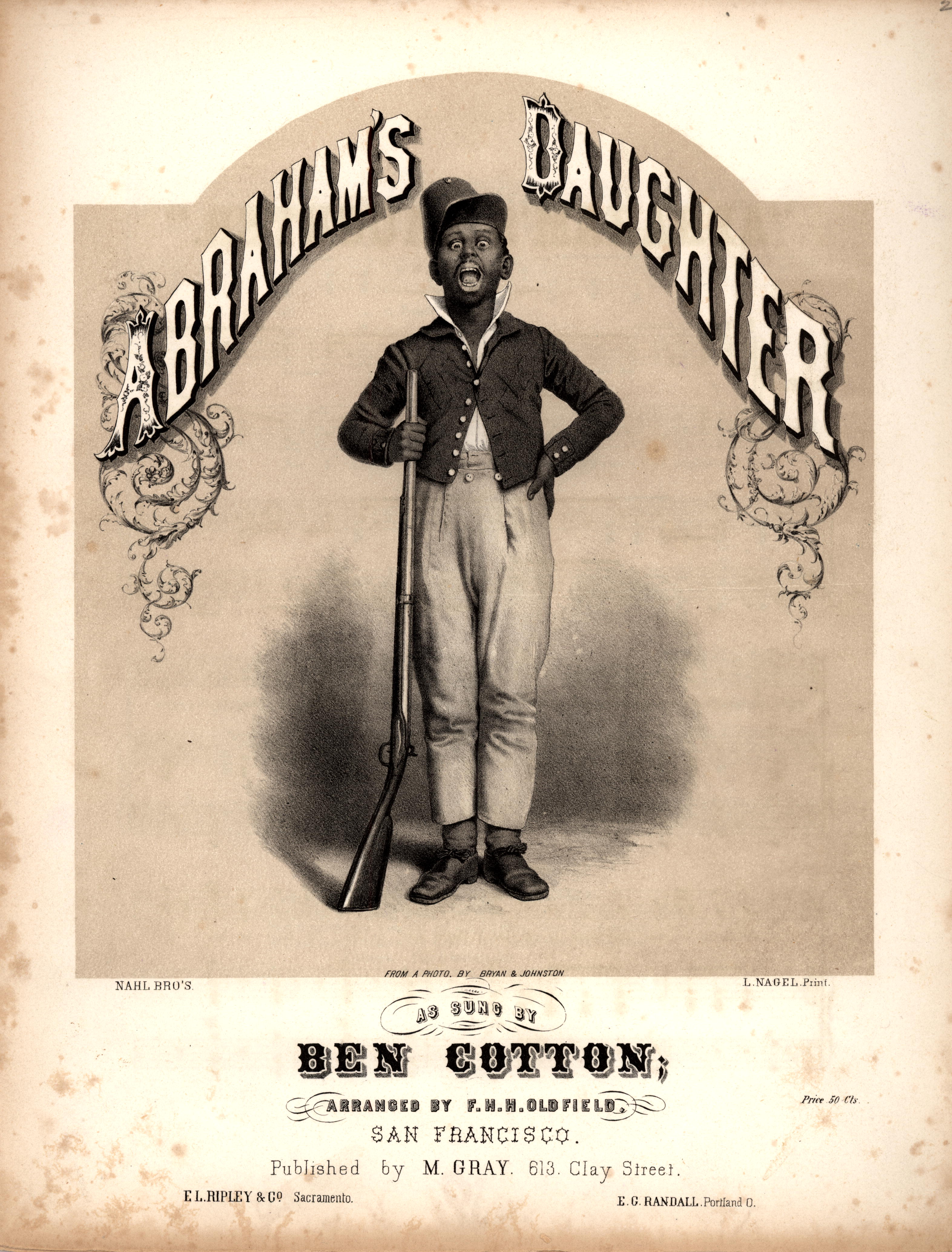
Near the end of his life Ben purchased a Harlem laundry as source of steady income in his retirement.
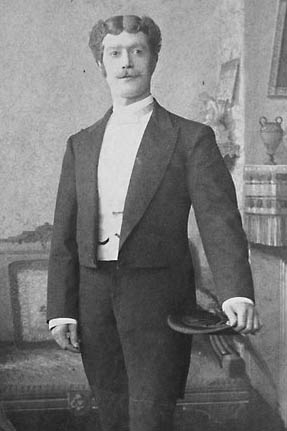 Idalene toured with her dad and was famous in her own right. He brought her and her brother, Ben Jr., into the family act as soon as they were able to perform on stage. Idalene never really had a life outside the stage. She met her husband in San Francisco, Nick Long, Sr. was a player at her dad's Alcazar Theater. There was a big difference in their ages.
Idalene toured with her dad and was famous in her own right. He brought her and her brother, Ben Jr., into the family act as soon as they were able to perform on stage. Idalene never really had a life outside the stage. She met her husband in San Francisco, Nick Long, Sr. was a player at her dad's Alcazar Theater. There was a big difference in their ages.
That's Nick Long Sr in 1884 on the right in the production of La Vie Parisienne. He was known for his expertise in foreign accents and often had roles as a Frenchman. He certainly looks "French" in that picture. I recently saw a silent film from the very end of his career. Nick Sr. looked exactly the same in 1926.
After Nick and Idalene married they toured up and down the West Coast from Seattle to Los Angeles. They performed in Europe and had reasonable success in vaudeville and on the professional stage. They were stars on the Orpheum Theater Modern Vaudeville circuit. One of their big hits was a 15 minute long comedy called Managerial Problems that was described as non-stop laughs. If a routine was successful it could get picked up to tour the US and Canada. The Longs were a big hit in Winnipeg. They continued to return to Los Angeles - in 1906 "the Protean playlet", My Wife's Diamonds played at the Orpheum Theater on Spring street. Perhaps they were getting tired of constant touring with two kids in tow. They decided to settle in New York and tried to establish steady employment there in long-term Broadway productions. They had a girl, Gladys, born on the road in Chicago in 1894, followed by Nick Jr., born on Long Island in 1904. They took little Nick with them all over the country and he is first reported in newspapers as a part of the act when he was just two. The press Nick grew up on trains, in dressing rooms and boarding houses - sleeping in a trunk. "Born in the tray of a Taylor Trunk", was what they used to say. He first appeared on the stage when he mistakenly stumbled on during one his parents performances; he was such a success with the audience that they incorporated him into the act. Nick played many roles, as Mabel Normand's younger brother and a blase adolescent for the Washington Square Players - always a street urchin.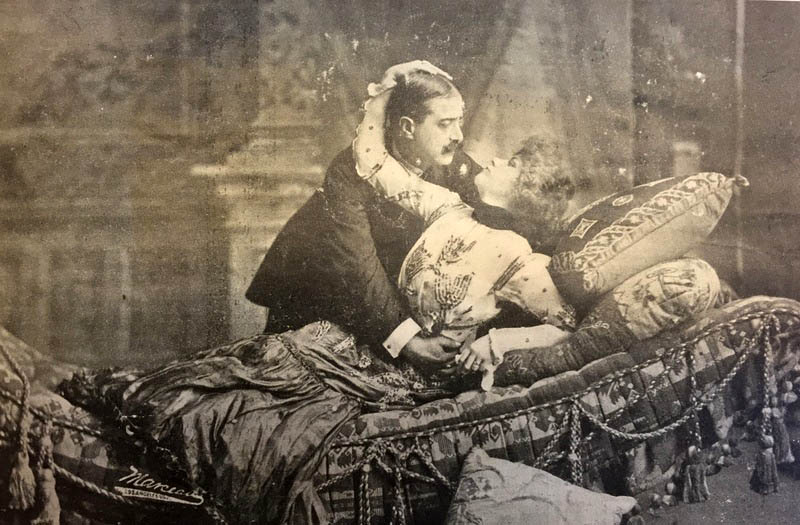
Above is a picture from 1890 of Nick's parents in Managerial Problems at the Alcazar Theater in San Francisco. This picture was taken before they were married. Ben Cotton, Idelene and Nick Sr. opened the newly renovated theater with a series of a dozen different productions.
As a boy Nick saw Douglas Fairbanks in the movie Robin Hood, which inspired him to head for Riverside Drive where he set to leaping over park benches and walls to the delight of onlookers. Once an audience of several hundred gathered to watch Nick scale the walls of Grant's Tomb. His dad came to take him away; discovering his new acrobatic talents Nick Sr. suggested his son incorporate them into his act.
In 1908 Idalene and Nick Sr, sued Klaw and Erlanger for $6,366 for ten weeks lost employment. Klaw and Erlanger had monopolized the hiring and management of vaudeville acts in New York and across the country. They also built theaters up and down the East Coast. One of them, The Iroquois, burned down in 1903 killing 600 people - mostly women and children. There were charges that the fire had been the result of shoddy building practices, but Klaw and Erlanger bought out politicians to avoid jail. They were thoroughly despicable characters with great power. I can't imagine that Idalene and Nick Sr. could have won their case. Fighting Klaw and Erlanger publicly was a risky venture that may have cost them future bookings - certainly Klaw and Erlanger would not have engaged them. Idalene and Nick Sr. were booked by the Shuberts. The $6,366 for tens weeks gives us an idea of what an act like theirs earned.
Despite an entire season of Nick Sr. performing alongside Lionel Barrymore, in 1914 his parents declared bankruptcy. At that point they had liabilities of $2600, which would have been around $65,000 in today's dollars. In 1915 the Longs were described in the press as "prisoners of the vaudeville circuit". They had a one lucky break from it when William Brady signed them for the legit theater in his own comedy production of The Things That Count at the Belasco Theater in Washington, D.C. which opened in March 1915. They got Nick Jr. a role in the production with them.
In an interview Nick said he was trained as a dancer by his dad, who also taught him to act, sing and do comedy. He must have dancing tips from his grandfather, Ben Cotton. All during his life Nick was known as a tap dancer, just like his dad. Often times he was described as doing "eccentric" dances. Eccentric dances were called novelty dances, which gave performers the ability to show off their technique in special routines and ethnic dances. His parents had worked with the famous dance instructor Ned Wayburn and they sent him to Nick's school in New York. Ned had done 6 shows for Ziegfeld and he had trained Fred and Adele Astaire when they were kids. In Wayburn's school you could learn how to dance, do your own make-up, maintain costumes, loose weight and lots of other things. Throughout the 20's and 30's Ned used Nick's name to promote his school in his advertisements in trade publications like Variety. Ned was very interested in the minstrel tradition and incorporated minstrel dances and patterns into many of his routines. He had seen Idalene and her father perform when he was young. This was another reason for his interest in Nick and his family.
Nick also attended the Professional Children's School in New York, where he says he practiced the soft shoe, eccentric and buck and wing styles of dancing. The Professional Children’s School was founded in 1914 by two reform-minded New Yorkers, Jane Harris Hall and Jean Greer Robinson. Ardent theatre-goers, the women learned of the plight of the city’s professional children – young people working in the theatre in New York or “on the road.” They learned that public and private schools could not or would not accommodate the schedules of stage children and, more often than not, children were simply skipping school to work on the stage. The school graduated it's first four students in 1916 and almost immediately had 1,000 students enrolled. The school provided a serious education and the teachers worked out of dedication to the school's mission. They were not paid well in the beginning and often had second jobs to make ends meet. Nick had many famous kids studying with him, among them Ruby Keeler, Milton Berle and Joan Blondel. He graduated with a high school degree. His dad wanted him to continue his studies at Columbia, but Nick wanted a career.
His first performance was at the age of 7 when he appeared with his parents on the stage in Saginaw, Michigan in 1911. His father dragged him onto the stage with him in the middle of a play, unprepared. In 1915 he was listed as a cast member in The Things that Count, along with his father and mother, this might be that production.
He studied ballet with Velodia Vestoff, who Velodia was I have no idea, I have found nothing on her so far. Maybe she was attached to Ned's school. Nick's first formal theatrical engagement was at the age of 9, when he appeared with an actress named Alice Brady at the Playhouse Theater in the Shubert Theatrical Production of Things that Count directed by her father, William Brady. Alice was a star of early silent movies and was a Realart star. In 1917 at 13 Nick appeared in his first film, The Corner Grocer, the story of a German storekeeper, who becomes rich through hard work, only to be ruined by a wayward son. Two years later he appeared in the silent movie The Oakdale Affair. Neither film has survived.
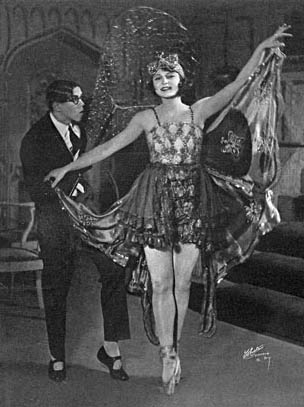 One of his first dancing roles was in a children's production of Daddy Long Legs. He was really busy performing as a child actor-dancer. Later, when he had grown too big to play a boy, he graduated to roles as a young man. From 1922 when he turned 18, until 1928 when he was just 24, Nick was in demand appearing in a number of productions, such as The Little Kangaroo, Lady Butterfly, Lollipop and Suzanne.
One of his first dancing roles was in a children's production of Daddy Long Legs. He was really busy performing as a child actor-dancer. Later, when he had grown too big to play a boy, he graduated to roles as a young man. From 1922 when he turned 18, until 1928 when he was just 24, Nick was in demand appearing in a number of productions, such as The Little Kangaroo, Lady Butterfly, Lollipop and Suzanne.
That's Nick at 16 on the left in Lady Butterfly, he's holding a net to catch the butterfly, danced by Janet Stone. He was brought into the production by the Morosco Brothers. This was his first professional appearance on the stage.
John Cort, the famous Broadway producer discovered Nick and put him in several of his productions. Nick was booked back-to-back. Even though many of the productions he was in were not a success financially, he got great reviews and was singled out for praise by the critics. During this time he developed the routine of combining dance with extreme aerobatics - called "Furniture Dancing" - leaping and flying over tables, chairs - and people as well. A young fresh face and powerful energy got him noticed, he became known as a dancing comedian. Lady Butterfly was something of a success, it had 128 performances on Broadway and its troupe of dancers appeared at a gala New York ball sponsored by the Paramount Club and attended by 2,000 people who paid $5.00 for admission. The ball was attended by movie people, actors, actresses, vaudeville stars and producers. It was highlighted by a performance-event called Midnight Frolic that was staged by dancers from the Ziegfeld Follies, Lady Butterfly and a long list of stars from other Broadway shows. Ned had staged Lady Butterfly and he was still working for Ziegfeld.
Lollipop was another production Nick was featured in, Bert French produced dances and routines for it. The 1924 show at the Knickerbocker Theater ran for 152 performances and is remembered for the introduction of Ada May Weeks to the public. She went on to become of Ziegfeld's most famous showgirls. It also starred Irene Dunne. Lollipop began in Philadelphia then went to Boston before landing in New York, all-in-all Nick had seven months in the production when he was 18.
Nick was 5' 8" tall - in the press they imagined he was taller. Several articles claimed he was nearly six feet tall at the age of 16. When he appeared in the production of Oh, Please he leaped head first over the backs of 10 girls - landing in a off stage net held by a team of 6 stage crew. Later this stunt was added to all of his performances. He was imitating the famous leap of the Russian ballet dancer Nijinsky, who soared through a open window at the end of Le Spectre de la Rose onto a mattress. Once, while in a performance of Kitty's Kisses in Chicago Nick was badly injured. During a performance the net was moved and he fell into a light switch box instead. His two front teeth were shoved into his upper lip and his face was badly damaged. Nick was also in an famous accident at the London Palladium. He was twirling around the stage and landed in the orchestra pit, where he smashed into a cello. He managed to get back on the stage and finish his routine. Feats like this got him a great deal of attention and more roles. Nick trained as a boxer, swimmer and an accomplished figure skater who did professional demonstrations of his technique. He was also a well-known weight lifter and was coached in physical fitness by Siegmund Klein in his famous New York gym. About this time he started lying about his age to get jobs. Newspaper reporters always badgered him about his marital status. He lied about this, as well. He claimed to have been engaged to a dancer from the production of Manhattan Mary - which he performed in with Ed Wynn - on Broadway, but this story was made-up as a cover for his being gay.
He also sang in some of his roles, like White Lilacs.
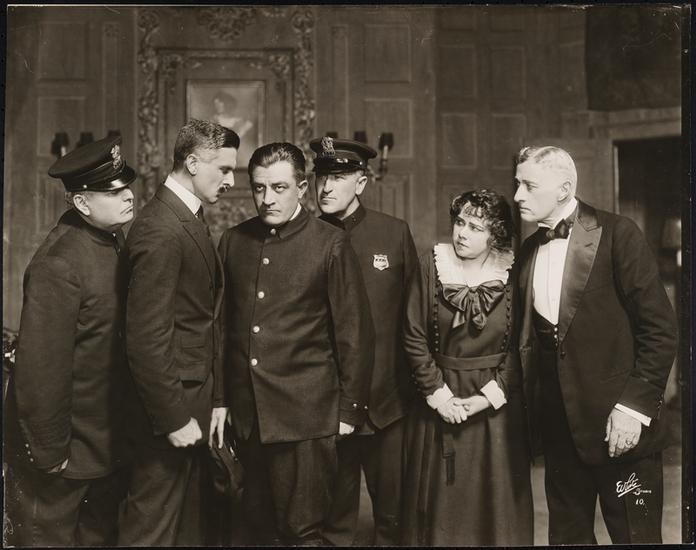 It appears Idalene retired from the stage in 1919 when she was 45. She appeared as Margaret Clancy in At 9:45 at the Playhouse Theater. There are three photographs of her in the production, one of them is shown on the right. That's the only record of a performance I can find. 7 years later, in 1926, Nick Sr. died aged 71, when Nick was 21. He died in Nick's apartment at 214 West 109th Street. Nick had two choices after his dad died and his mom retired, he could tour or find work locally in New York. He was probably his mom's sole support. Lucky for Nick, his mom and his sister the income his dancing and acting was there to keep the family together. Nick's career was being managed by Charles Dillingham, the famous Broadway producer. Dillingham had worked with Nick's parents and was also a friend of the family, so he had a personal interest in Nick's success.
It appears Idalene retired from the stage in 1919 when she was 45. She appeared as Margaret Clancy in At 9:45 at the Playhouse Theater. There are three photographs of her in the production, one of them is shown on the right. That's the only record of a performance I can find. 7 years later, in 1926, Nick Sr. died aged 71, when Nick was 21. He died in Nick's apartment at 214 West 109th Street. Nick had two choices after his dad died and his mom retired, he could tour or find work locally in New York. He was probably his mom's sole support. Lucky for Nick, his mom and his sister the income his dancing and acting was there to keep the family together. Nick's career was being managed by Charles Dillingham, the famous Broadway producer. Dillingham had worked with Nick's parents and was also a friend of the family, so he had a personal interest in Nick's success.
Nick's older sister, Gladys, was an actress. She appeared in a number of David Belasco productions in New York including The Sun Daughter and The Man Who Came Back Gladys married a theater electrician named Harry Davis. When she died on February 28, 1945 Harry was working as the head electrician for Harvey at the 48th Street Theater in New York City.
In the 1920's Nick's agent was Max Hart, his offices were at 1560 Broadway and he represented dramatic and musical artists. Nick worked with stars Beatrice Lillie and Jose Ferrer in Oh, Please in 1926 where he danced in tux and tails. Max was placing many of the artists he represented in the same productions for Dillingham.
Also in 1926 Nick starred in Kitty's Kisses for Ziegfeld on Broadway at the Playhouse where he repeated his "showgirl" leap at every performance. It ran for 5 months. In 1927 he had a huge success with Clifton Webb in She's My Baby, audiences went wild watching him dance in this production. There were several routines, once of which was a dance number in black face, an obvious irony considering who his grandfather was. In 1928 Nick bought a brand-new Nash 400 sedan that cost around $1500. Here's a picture of Nick with his car that was in Variety. He could afford a car like that after a string of successful paid engagements. He was spending time in Groton Long Point and hanging out with rum-runners.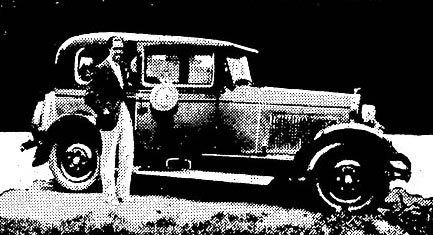
Douglas Fairbanks, with his adventure-costumes and swashbuckling roles continued to be a model for Nick. He developed a star-struck childhood crush on him. He dressed like him, had the same mustache and found himself being photographed in poses just like publicity shots for Fairbanks 1922 movie, Robin Hood. The greatest compliment one could make was to compare Nick to Fairbanks and the press often did this in a very favorable way.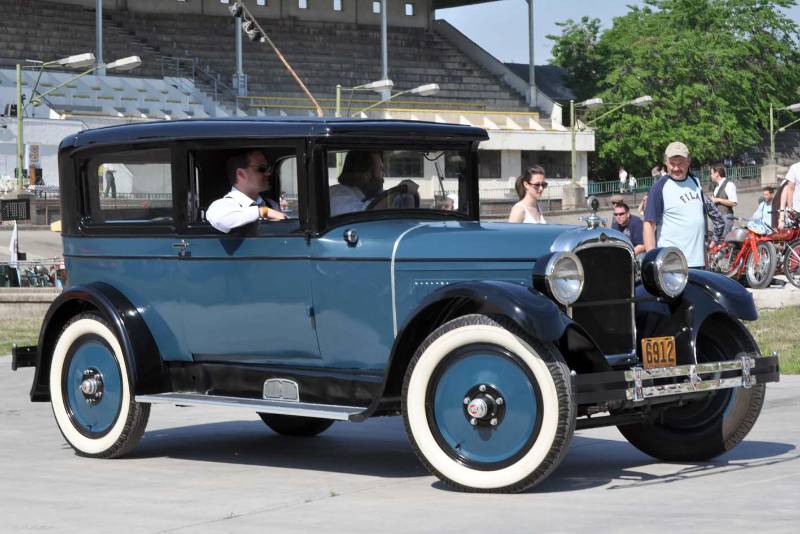
Nick first worked with Busby Berkeley in the production of the Street Singer at the Shubert Theater in 1929. He had number 2 billing in this highly successful musical comedy, playing the character of Ronnie. Busby Berkeley then hired Nick to dance in Flying High a highly successful musical comedy on Broadway in 1930. It stared the "Cowardly Lion" Bert Lahr and Kate Smith and ran to packed houses for a year. I suspect Nick's highly individual dance technique would not have appealed to Berkeley and his obsession with patterned, geometric dances. He doesn't appear to have worked with him on any of Berkeley's many movies. Nick was in constant demand as a performer throughout 1930 and was booked, once again, in back-to-back productions. He had more excellent reviews, although he was starting to get type-cast, one writer commenting that he was bouncing around the stage "as he always does".
In December 1930 The Dance Magazine gave Nick a giant, two page photo spread of him demonstrating Knock on Wood a musical comedy dance that could be performed to any syncopated fox trot music. He was shown with Peggy Cornell who danced with him in The Street Singer. He wears his signature white carnation in his lapel. Archie Leach (aka Cary Grant) was in The Street Singer with Nick. He gave out many signed photographs of himself in this outfit taken by the famous Broadway art photographer, G. Maillard Kesslere, which he bought in bulk from his studio. He gave out many signed photographs of himself in this outfit taken by the famous Broadway art photographer, G. Maillard Kesslere, which he bought in bulk from his studio. The photographer was gay and known for his nearly pornographic images of naked show girls. His images of Nick excessively softened out his features - a trademark technique of the photographer. His overly manipulated pictures were very popular with Broadway performers. Another New York photographer Nick used in the 30's was DeBarron Studios. The founder was Paul Barron. He added the De to his name when he and his partner opened expensive facilities in New York City. Their pictures of Nick (sans-moustashe) show every single detail in his face. His teeth look almost frightening. Paul Barron was known for eliminating shadows from his pictures, shadows covered up unattractive features or signs of aging. Only brave, young stars could afford to submit to his camera.
Oscar Hammerstein II invited Nick to participate in the annual Kiwanis Club Children's Hospital Benefit at the Art Deco Paramount Theatre in Palm Beach, Florida in 1932. Irving Berlin wrote a couple of speciality numbers for Nick to perform. Berlin was on the Board of Directors, along with Billie Burke, Florenz Ziegfeld (prior to his death in 1932) and George Gershwin. Nick returned for benefits in 1937, 1939 and 1947. In 1939 he brought his buddy Danny Kaye with him. In 1947 he brought his whole show from the Copacabana Club. Nick got to know Ed Sullivan during his visits to Palm Springs and the Kiwani's Club benefits, They played the slots (Nick was delighted when he won and kept playing) in a Florida casino and Ed wrote about it in his newspaper column.
In May 1933 Nick appeared at Radio City Music Hall in the John Murray Anderson's production of Oscar Wilde's Nightingale and the Rose. Nick danced a subset of the production called The Giant Cage to the music of Rimsky-Korsakov's Capricco Espagnol. In this role he played a black-robed trainer with a whip who directed the Roxyette dancers who whirled around him dressed in furs which they discarded as they moved in circles. There was a revolving stage.
NEW - You can watch outakes from a dance demo film featuring Nick - it's a great opportunity to see him dancing in the early '30s on YouTube.
Later, after Nick hit Chicago and Chez Paree, he used the Burlesque photographer, Maurice Seymour, who had his studio on the top of the St. Clair Hotel in Chicago. Maurice Seymour also was known for taking highly artistic pictures of ballet dancers; he was the official American photographer for Leonid Massine and the Ballet Russe de Monte Carlo. Seymour's pictures of Nick show him wearing heavy theatrical make-up in dramatic dance poses. Nick kept copies of all of his publicity shots and passed them out on tour to fans and fellow artists he worked with. As he got older he and his agents preferred the more natural DeBarron Studios pictures.
In 1934 Nick was sued by Select Theaters Association for breach of contract. Select Theatres produced shows on Broadway in New York. Later in that year Nick appeared in Say When for the Shubert organization and this dispute may relate to that. Nick may have wanted to get out of his contract to continue working in London. Bob Hope was in Say When with Nick.
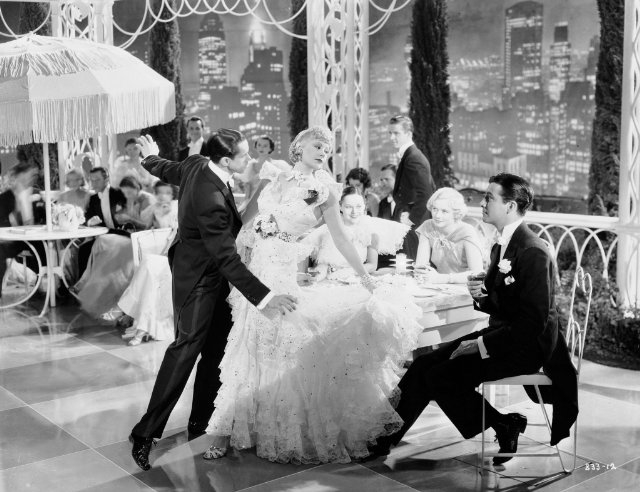 Between 1930 and 1938 Nick made at least three trips to London. In 1931, when he was 27 he got long-term work there that continued to boost his career. Fred Astaire took Nick to London to perform in Ziegfield's Smiles. During this engagement he was stranded without pay when his agent left the entire American company without funds. Fortunately Nick had his return steamship tickets. He did a few more bookings in London to cover his loses.
Between 1930 and 1938 Nick made at least three trips to London. In 1931, when he was 27 he got long-term work there that continued to boost his career. Fred Astaire took Nick to London to perform in Ziegfield's Smiles. During this engagement he was stranded without pay when his agent left the entire American company without funds. Fortunately Nick had his return steamship tickets. He did a few more bookings in London to cover his loses.
In January 1934 Nick was appearing at the Dorchester Hotel. He sailed to London with a horde of 12 beautiful, young New York showgirls, their chaperones and a music composer named Michael H. Cleary on the French Lines ship Champlain. The ship arrived on January 6th in Plymouth. Nick sailed in second class while the rest of the team went tourist. All were bound for the engagement at the Dorchester where they appeared in the Midnight Follies, imported to Britain from Grandlund's New York Paradise Club. There were 30 performers in the show and it opened on January 26th.
Nick was accompanied by a 20 year old singer, Vera Renee Haal, and six showgirls, Dorothy Hardy 19, Betty Lustre 16, Marion Wolberg 16, Florence Gentry 15 and Beatrice Gonia 21. The youth of the dancers is notable. Betty's mom, Harriette came along as a chaperone.
Vera "Renee" Haal (September 1, 1919 – May 24, 1964) was an American stage and motion picture actress and singer, she traveled with Nick and was a star in the Midnight Follies. On this visit to London, she met met the actor/director/screenwriter, Peter Godfrey whom she married two years later, he was almost 20 years her senior. Her life-long best friend was Barbara Stanwyck. Vera made quite a splash in London, actress June Lang saw the show at the Dorchester and said Vera was the most beautiful woman she had ever seen. She had competed in the Miss New York State and Miss America pageants. When she was older Vera appeared in TV shows like Perry Mason, Donna Reed and Hazel.
Also joining the cast at the Dorchester was June Taylor, the dancer who would become famous when her June Taylor Dancers appeared on Jackie Gleason's show in the early 1950's. She and Nick met at Chez Paree, where she got her start in show business, They became life-long friends and worked together in the 1940's, spending almost year on tour together.
Michael Cleary was in charge of the musical production at the Dorchester. Cleary's best known songs were "Singin' in the Bathtub" and "H'lo, Baby", which gives you an idea of the popular appeal of his music. He wrote the Broadway stage scores and songs for revues including Earl Carroll's Vanities (1931), Shoot the Works, and Third Little Show. He wrote special material for night clubs, Kate Parson's Show Boat Revue, and songs for films. He was a graduate of the US Military Academy.
The Diamond Brothers were on the bill for comedy, Jayne Manners sang and Toni Chase was on the piano. In 1930 the Diamond Brothers had worked on the Orpheum vaudeville circuit with Bob Hope. Bob was on the northern circuit that took them "way north" to Winnipeg, Calgary, Minneapolis, Tacoma and finally Seattle. While in Seattle the three Diamond boys introduced Bob Hope to golf. He got hooked the first day he played - with clubs borrowed from the Diamond Brothers. In 1935 the Diamond Brothers appeared at the London Palladium for the Royal Variety Performance before King George and Queen Mary.
Nick met many celebrities in England. One of his admirers was Max Bacon, the famous drummer and comedy actor. Even though he was born in the UK, his comedic style centered on a pseudo-European, Yiddish accent and in his straight-faced mispronunciation of words. Max was short and balding, loosing much of his hair before he was 30. He was a long term member of Ambrose's Orchestra. Max had a long career; one of his last roles was in the movie Chitty Chitty Bang Bang in 1968. He never married.
David, the Prince of Wales, attended one of Nick's performances at the Dorchester. The Prince loved it and met with Nick privately afterwards to congratulate him. Nick's agent took out a big ad in Variety celebrating Nick's accomplishment.
Jerry Lewis described Jayne Manners from his own personal experience, she had been a headliner for him and Dean Martin: "she made sure the people knew exactly what her act was about. She spelled it right out for them - Big boobs - funny. A big-breasted blond singing badly - funny. A big-breasted blond making off-color remarks".
Michael and Nick were also working with Clifford Whitley and Felix Perry on a big West End musical production that doesn't seem to have been produced. It had a $75,000 budget. Michael was to produce the score. The American productions at the Dorchester were very popular, the hotel built a huge 1000 seat luxury restaurant in the garage to accommodate them. Louis Shurr was representing Nick at this time and placed big ads in Variety trumpeting Nick's London success. Nick "did some neat hoofing, with and without the girls". 25,000 people bought tickets for the show. Shurr was a highly successful theatrical and Hollywood press agent who represented Bob Hope, Cole Porter, Lila Leeds, Bert Lahr, Clifton Webb and many others. Shurr was known as The Doctor for his ability to “cure” an ailing show. He began working with Cole Porter in 1927. I have also found that Nick was represented by the William Morris agency in 1935.
The 30's were great for Nick. He did three movies for Hollywood and performed several times at Al Capone's Chez Paree in Chicago. Nick's most famous movie was Broadway Melody of 1936 . Nick was invited by MGM to audition for the movie. Nick's agent, Louis Shurr, also worked as a talent scout for the studios and was paid finder's fees for locating new talent. Buddy Ebsen and his sister and Eleanor Powell - all newbies to Hollywood were also invited among others to test. It was front page news in New York that Nick was being tested. He was just finishing 10 weeks at Chez Paree. His test in March 1935 was a success and he was hired for the film. Production stated immediately (officially July 1935) and took three months. There was a sneak preview in Santa Barbara on August 14th and a World Premiere in New York on September 18, 1935 at the Capitol Theatre, with all the stars in attendance.
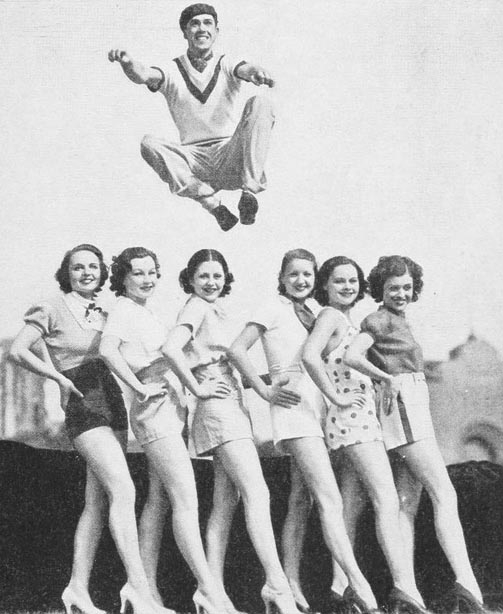 On the right is a publicity picture for Broadway Melody showing Nick flying over 6 chorus girls.
On the right is a publicity picture for Broadway Melody showing Nick flying over 6 chorus girls.
Dave Gould, the Hungarian-born dancer and choreographer, was the dance director for Nick's film Broadway Melody of 1936. Before this he had been the dance director for Flying Down to Rio, which starred Fred Astaire and Ginger Rogers. Flying Down to Rio was a huge hit, one cannot overestimate its impact on Hollywood and the movie public. It made a huge amount of money and the reviews were great. All the studios switched gears and began to hunt for projects like it. They needed dancers and dance directors. Gould was one of the three winners of the Oscar for Dance Direction before it was discontinued. Busby Berkeley was another winner. Hermes Pan had been Gould's assistant so I am sure he and Nick met when he was in Hollywood. Nick might have been offered Broadway Melody because Fred Astaire was working on Top Hat and unavailable, besides both Astaire and Rogers were RKO properties.
The studios were concerned that the public was getting tired of Busby Berkeley's patterned dance routines and they were looking for something new. Flying Down to Rio had a modern feel to it, it was casual, sophisticated and elegant as well. It made movie goers feel good.
In Broadway Melody they tried a bunch of new things. They brought in Nick with his athletic jumping as something new and different. In the first dance routine they had furniture and a fountain that popped up from the flower and magical flowers that burst into air. They had costumes that transformed colors and used split screen techniques. It started with Nick leaping over the backs of bunch of showgirls center stage. That would have really looked impressive on the big screen. There was also a line-up of 8 dancers that Nick jumped over, one-by-one. At the end the on-screen 'audience' applauded. This was the first time anyone had seen Nick in the movies and his bundle of dance tricks. They were so distinctive it was obvious that they were a one-time event. I am sure Fred Astaire was dumbfounded when he saw Nick's performance. He and Pan must have had long critical discussions about the dancing in the movie. At that point nobody, including him, could do those things. Nobody could until Gene Kelly came along. It should be said that Astaire would not have been a fan of the circus aspects of Nick's dancing. As a professional dancer and movie actor he would have seen technical aspects of Nick's performance that others might have missed. He also would have noticed how the music was dubbed and the transitions in editing dances. These were all things Astaire and Pan had control over. Nick was new to Hollywood and did not have creative control over anything. Gould and the director would have told Nick exactly what they wanted and how he should dance. Although he had been a big success in New York and Chicago none of this meant anything in Hollywood. He would be judged on how successful the film was financially and his reception by the public.
One of the innovations in Flying Down to Rio were the naturalistic transitions from the acting parts into the dances. In Broadway Melody the last dance finale starts with Frances Langford singing Broadway Rhythm in a cabaret. The camera pans across a line of tall singing blond women in outlandish Adrian designed gowns who are holding wands that move from left to right as the camera follows them. The camera then takes us back to a huge rooftop New York nightclub with an arena-like dance floor. Here we see a big chorus of men and women in formal attire dancing and singing Broadway Rhythm. There is then a complete mood transition to Nick and June Knight in a sexy and sultry duet. The lighting is very different and there are a lot of close-up shots. The duet merges into the chorus and ends as we see Nick slightly loose his balance. The last part of the finale was completely dominated by Eleanor Powell, in an amazing glittery sequined tuxedo and top hat, also designed by Adrian. There was a huge close-up of her face at the opening of her dance. She stole the show. The studio was shocked at the audience reaction to Powell's dancing in the previews, she was an instant star! The routine was so powerful that I think movie goers and critics overlooked Nick and June Knight's amazing duet that had just preceded it. After this Powell went on to be a huge star.
I wonder why Nick's career in Hollywood never took off after Broadway Melody. His dancing was superb. During production of Broadway Melody the PR department of the studio wrote articles about the boy-wonder of New York who soared through the air to the amazement of the MGM crew. they pegged him the "human rubber ball". He was 30 at the time, but his boyish looks made him look younger. Did the Hollywood powers-that-be nix Nick's movie career - why? His dancer co-stars Eleanor Powell and Buddy Ebsen went on to success in the movies, but not him. Buddy Ebsen's sister Vilma had danced with him in the film, but her career in the movies immediately slammed shut. There was something weird about seeing them dance their comedy routines - for one thing she was much, much shorter than Buddy. It felt okay for her homely brother to do the clownish choreography, but they didn't quite fit on her. They said she decided not to follow a movie career after this debut for personal reasons.
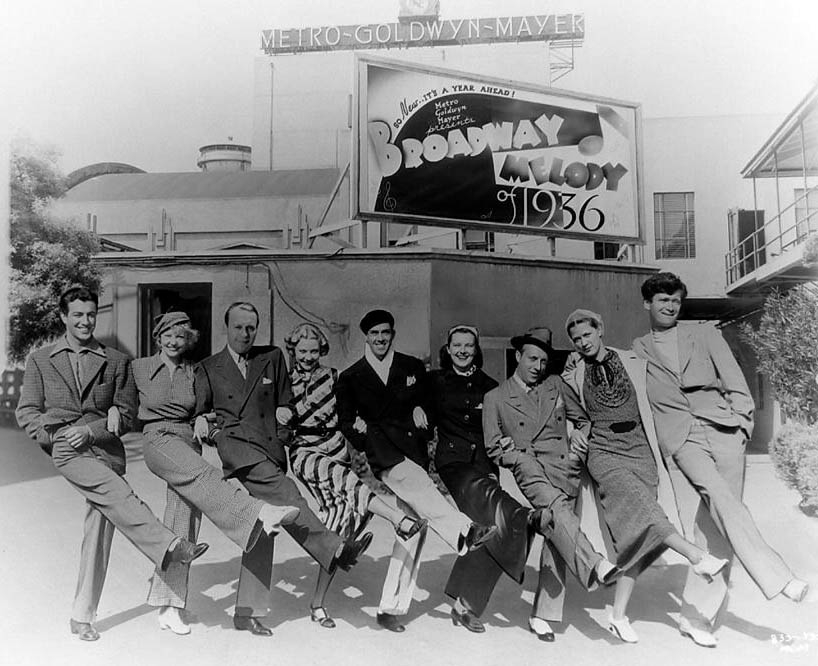
Above is a promotional shot for Broadway Melody of 1936, that's Nick in the middle looking very elegant in a double-breasted blazer and swanky beret. Perhaps Nick and Astaire looked too much alike and the studios thought it would confuse audiences. Maybe Nick's drinking was already a problem. Maybe there was a scandal of some kind and the studio didn't feel Nick had big enough star potential for them to invest in keeping his public image clean. It's possible that Nick just didn't have a trusted Hermes Pan to coach and look after his career. One of Nick's innovations was the wearing of a "bathing costume" in rehearsals and in his dressing room. Bathing costume is what they called tights in those days. Female dancers adopted tights later.
Next's next film project was the The King of Burlesque - you can watch it here. The film was in production for a little over a month - from September 30 - November 9, 1935, so this film would have wrapped before Broadway Melody opened. The film started Warner Baxter, Alice Faye and Jack Oakie. The storyline is a guy, Kerry Bolton, who is the top producers of burlesque shows wants to make it on Broadway. Nick plays an aspiring dancer who wants to be discovered and star on Broadway. Nick wrote some new scenes with Jack Oakie to beef out his role, but they were not included. He has an odd scene towards the beginning of the film where he visits Oakie's office looking for his break. Nick is dressed like he always does, in a blazer with a white carnation in his lapel. He has a couple of lines of dialog and he jumps in the air. We next see him at the end of the movie where he appears in a tux and dances with a big chorus of showgirls. This is proceeded by a scene involving a revolving stage and lengthy footage of girls in trapezes swinging over an upscale nightclub. The following dance showcases Nick's bravura technique and skill at turns and leaps. There are jumps over individual girls. There isn't much romantic dancing going on, it's mostly the solo routines she was really good at. At the end of the dance Nick does his signature leap over the backs of six showgirls and lands in a net off camera. It's really amazing to see - he literally flies through the air like Superman. You can see why audiences wanted to see him do this, over and over again! Poor Nick. There is a real difference in what Astaire allows up on the screen and what we see Nick dance. Nick always has to be the acrobat. He must have felt like a trained seal. Astaire had creative control over and Hermes Pan to work with him on the choreography. Producers gave Astaire time to perfect his musical numbers. He was not a trained ballet dancer and always wants to his dancing to look natural. Then Astaire had Ginger Rogers. I do not think Astaire would have been a success in films without Ginger, no matter how good his dancing was. Astaire tried to get out of co-starring with her and the studio refused to allow it. Actually he spent far more time dancing in rehearsal with Hermes Pan filling in for Ginger than he did dancing with her. Astaire learned to be cagey when it came to the public and their fixation on the Astaire-Rogers coupling; they wanted it to be real and they didn't like hearing Astaire put her down in any way. He couldn't wait to escape further work with her and looked for projects that he knew she would be unavailable for because of scheduling.
Nick would have been lucky to have had the same problem as Fred. He had little or no control over what he was asked to do. Sammy Lee was listed as the dance director. Nick had already worked with him on Broadway Melody. The King of Burlesque did nothing to further Nick's career, he hardly acts in it and the dance routine is much shorter than his work in Broadway Melody. His agent must have booked this as an add-on to Broadway Melody and Nick's stay in Hollywood. It's too bad Nick doesn't have a Ginger to dance with in this film. Alice Faye must not have been a dancer. You can order The King of Burlesque on Amazon or iTunes. Here is his dance routine in the film on YouTube:
After the success of Broadway Melody and the completion of The King of Burlesque, Nick took his mom, Idalene to London with him, leaving the day after Christmas, 1935. They traveled First Class on the Hamburg-Amerika's liner Deutschland. The ship held 950 passengers and 470 crew; the Trans Atlantic Passage took 7 days. There were accommodations for 180 in First Class, in London they stayed at the Park Hotel. On January 10th, 1936 Nick began a five month engagement dancing to Fredrick Ashton's choreography in Follow the Sun a Charles Cochran review in Manchester and London. Ashton himself had to had to fill in for Nick during the first two weeks. The show opened in the Opera House in Manchester and then moved on to the Adelphi in London. Clare Luce was Nick's partner. It is not well known that Ashton contributed to a number of West End reviews and musicals in the 1930s while he was working for Ninette de Valois at the Vic-Wells Ballet. Considering how many dancers there were in Britain at the time it's worth noting that Cochran and Ashton picked Nick. Two of his costars were Sarah Churchill, Winston's daughter in her first theatrical gig, and Vic Oliver, an Austrian-born comedy man who Nick had met in New York. Vic Oliver married Sarah Churchill. Cochran had hoped to bring Follow the Sun to New York, but it didn't happen.
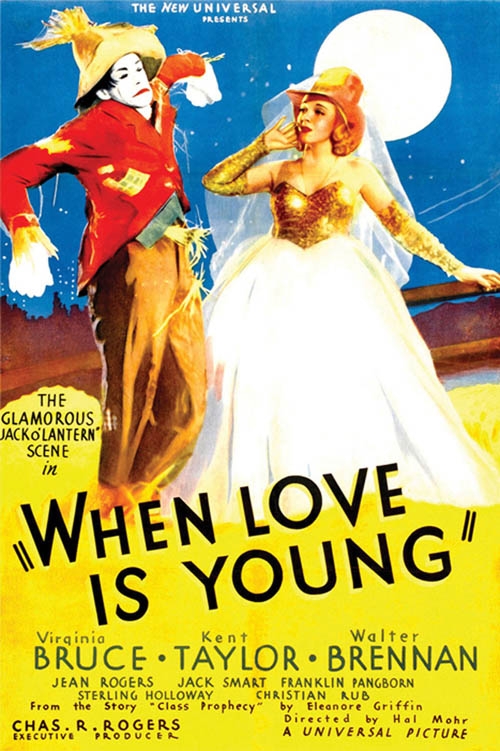 Nick's next Hollywood film was When Love Is Young which was directed by Hal Mohr. The storyline is basically a Cinderella one, with a play-within-a-play inserted in it. It opened March 28, 1937. Production started in December 1936 and the original name of the film was "Class Prophecy". It was a Universal Pictures production and was filmed at Universal Studios. Universal Pictures had recently been seized in a hostile take over when the film was made. The studio had been in chaos since the financial debacle of James Whale's Showboat in the same year. After a string of successful horror films like Frankenstein, studio management had decided to produce artistic properties. Showboat had gone way over budget. Universal had taken out a big loan to produce it, when the loan was called in the lender, Standard Capital Corporation, took over the studio. "When Love is Young" was produced in a difficult period under the management of bankers not film makers.
Nick's next Hollywood film was When Love Is Young which was directed by Hal Mohr. The storyline is basically a Cinderella one, with a play-within-a-play inserted in it. It opened March 28, 1937. Production started in December 1936 and the original name of the film was "Class Prophecy". It was a Universal Pictures production and was filmed at Universal Studios. Universal Pictures had recently been seized in a hostile take over when the film was made. The studio had been in chaos since the financial debacle of James Whale's Showboat in the same year. After a string of successful horror films like Frankenstein, studio management had decided to produce artistic properties. Showboat had gone way over budget. Universal had taken out a big loan to produce it, when the loan was called in the lender, Standard Capital Corporation, took over the studio. "When Love is Young" was produced in a difficult period under the management of bankers not film makers.
Hal Mohr was a famous cinematographer, not a well known director. It stared Virginia Bruce, a popular film star of the 1930's. I would not call her or any of the other stars first-tier. Walter Brennan was also in the film. Credit for Production Design was given to John Harkrider and Nick, but it seems their only contribution that was credited in the movie is the jack-o-lantern scene. John Harkrider was a famous costume designer for Hollywood films and was an out gay man. Vera West is credited for the costumes in the firm.
Nick did the choreography and dance direction, he also danced the role of the scarecrow. There is a long dance sequence which is set as a scene in an onstage musical. It is shot in a cornfield at night. Virginia Bruce wears a gown that is very similar to that worn by Billie Burke in The Wizard of Oz. She finds a scarecrow, danced by Nick, who comes to life through magic. He has a very challenging dance, leaping downstage at a steep angle. There are a number of ballet steps that Nick does very well. His characterization of the scarecrow is very good. The scarecrow is then transformed into a handsome dancer in a tux. Nick then dances a romantic duet with Virginia Bruce, who can't dance. Nick dances around her and supports her very well. At the end of the dance he changes back into the scarecrow. The very weird thing about this dance is that the setting, the make-up and Nick's choreography and very similar to what Ray Bolger does in the Wizard of Oz two years later. It looks like it was copied. The main difference is Nick's choreography has ballet steps in it and it's in black and white, not color. The film was not a success at the box office. One review called it brittle and artificial, but complimented the director for pulling off what should have been an unbelievable story. He said the performances were just "ok". He doesn't comment on the dancing. Looking at the production crew it looks to me like a bunch of people came together to make their own breakthrough film. Nick is not credited as the scarecrow, his picture appears on the film posters and was the primary tool used to market the movie. You can see the poster on the right.
Considering the situation at Universal Pictures when When Love Is Young was produced and released it is no surprise that the film was badly promoted and did not get into many theaters. They had slashed production budgets and this meant the producers could not afford a more experienced director. Who knows what effect cutting the money had on the look of the film, its sets and costumes. The film or his work at Universal did not advance Nick's career, the studio had not even given him screen credit. They did not produce any more films with him either. I suspect Nick had been signed up for the film by Carl Laemmles Jr., prior to him being evicted from the studio his family had founded by the money guys at Standard Capital. Once they were in charge they might have pulled the plug on what might have been a much bigger production and cut back on Nick's choreography and the musical numbers in the film. Maybe Nick wasn't paid. Even if he was dance directors were not paid very much in those days. There were three other people who contributed to the film but were not credited, Dawn & DeGraw and Frank Pierce. Frank was a makeup man at Universal.
One other alternative scenario - Nick and Harkrider were brought in during production just to produce the one dance routine for the film.
A reporter visited the set during the filming of the Jack-o-Lantern scene. The director, Hal Mohr told him that the haystacks were made of wheat straw imported 500 miles from Sacramento because it photographed better. Thousands of cellophane straws were added to the tops of the haystacks to get sharper highlights. The frosty effect was achieved using a substance called diamond dust "the kind of stuff that is sprayed on coffins", said Mohr. The path through the haystacks was made of hundreds of ordinary doormats. Lamemmles had a relative in the doormat business and he brought thousands of them.
In 1937 Nick appeared for three months at the Metropolitan Theater in Boston in a vaudeville show. He danced with the legendary Nadine Gae, a partner he had worked with before. It is not surprising that serious professional dancers like Nick and Nadine did vaudeville. Ruth St. Denis got her start in vaudeville. Anna Pavlova performed in Music Halls with trained dog acts. In this show Nick did some solos performed with and without the orchestra. They did some semi-eccentric dances.
Nadine was an exotic brunette and very busy dancer on Broadway, She appeared as Chiquita in Cole Porter's Panama Hattie in 1940. Life Magazine featured her in a photo spread in 1941; according to the article her claim to fame was not only being a dancer, but having the world's biggest collection of underpants that she kept in the New York City apartment she shared with her husband, Ray Sacks. They performed together in a musical novelty act. In 1943 she appeared in the reborn Ziegfeld Follies (the Shubert's had purchased the Ziegfeld brand after his death in 1932), dancing with Tommy Wonder, which were the most successful Follies in history. It ran for 14 months and starred Milton Berle. She also appeared with dancer, Peter Hamilton in unsuccessful dance-concert performances. Nadine had been a pupil of Charles Weidman, one of the pioneers of modern dance. She toured with his dance company in 1947 as a guest artist (Peter Hamilton, too). In 1947 she appeared at Jacob's Pillow with them.
In 1938 Nick returned to London. This trip to London was special because he Danny Kaye went as his stage 'stooge' and partner. They shared a cabin on the ship.
Many people are interested in finding out about Nick's work with Danny Kaye. It started prior to the trip to London at the 4,000 seat Cafe Manana in New York in a Billy Rose production that also featured Jimmy Durante. They had a comedy-skit sort of routine where Danny rushed through the audience shouting with a Russian accent. The set was some sort of boiler room. This earned Danny the nickname "The Mad Russian" from Nick. Betty Hutton was also in the review and Nick choreographed a special comedy dance for her, Nick and Kaye that Billy Rose really liked. Nick was really proud of Danny's performance and went around praising him. His routine was not will received - Kaye got marks for his clowning around, that's all. The jokes between Nick and Danny did not come off, except for Nick's 'swell', imitations of Buddy Ebsen and Eleanor Powell. They took the act to London, where it also failed. Poor Danny, Variety kept misspelling his name as Danny Faye and Davy Kaye. International Film News reported from London that Nick shaved off his signature Clark Gable mustache while he was there. He had done this once before in 1936 during a run at Chez Paree in Chicago, this would be permanent.
Autumn Laughter was the name of Henry Shrek's show at the Dorchestor and it is also remembered for having been a pioneer BBC television broadcast. Nick and Danny appeared in it along with the other stars of the production. The TV broadcast was on two days, September 21 and 23, 1938. I have not been able to find a recording of it. Mysteriously, a television broadcast from the BBC in November 1938 was picked up in New York and recorded by a camera filming the screen. You can see it here. I was astonished to learn there were almost 10,000 TV sets in Britain in 1938.
Perhaps the threat of war in Europe brought Nick back to New York at the end of 1939. He had been planning to return for at least one more season at the Dorchestor and that was cancelled because of the war. Nothing would be happening there until after 1946. Nick had banked on advancing his career in London, where he was appreciated and paid well, and now that door was closed.
On New Year's 1940 Nick opened in Ziegfeld Midnight Frolic in New York at the Paradise Club with Eunice Healy. Nicholas Blair and Seymour Felix totally revamped the Paradise to try and revive the old glory days of Ziegfeld. He danced to Rachmaninov's Prelude in C sharp Minor followed by a rhumba number. Next there was a psuedo-hillbilly dance number called "I Get a Kick Outta Corn" danced by Nick and a bunch of showgirls in hillbilly clothes. The showstopper was Nick and Eunice doing recreations of Astaire and Rogers dances to a full orchestra.
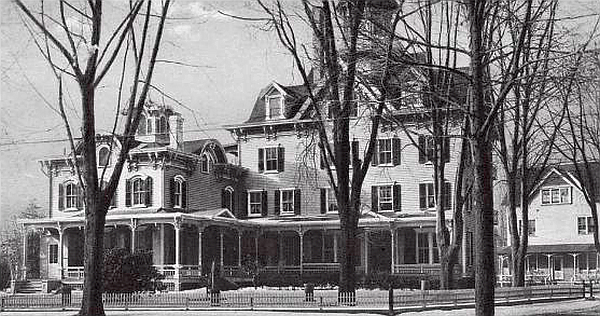 Idalene, Nick's mom, died of a heart attack in late 1940. She probably died alone, without either of her children present. The death announcement in the New York Times said it was sudden. Variety said the same thing. She died in Brunswick Home in Amityville (yes, THAT Amityville!), Long Island - New York as the guest of the Actor's Fund. When it was opened the Brunswick Home - seen at right - optimistically provided each 'guest' with a private room that was described as being "light and airy and well furnished". It operated primarily as a rest home for the elderly, it did not admit people with mental illnesses. A number of performers of the time died here. The fact it was a home for indigent theater people means Idalene was probably destitute at this point of her life and Nick was not able to help her financially. She had been in the Brunswick Home for most of 1940, if not longer. Having other performers around means she had people to talk to, share her stories with; maybe some of them had seen her on stage. The nurses and doctors would have known show folks like Idalene very well. The hospital when Idalene was there was fairly new built in 1931. men, women and children all had separate wings. The women's wing, to the far right in the picture, was three stories and was surrounded by a open porch. A year after Idalene died, in November 1941, there was a horrible fire and the Brunswick Home burned down, killing four patients in horrific circumstances. It was rebuilt in brick.
Idalene, Nick's mom, died of a heart attack in late 1940. She probably died alone, without either of her children present. The death announcement in the New York Times said it was sudden. Variety said the same thing. She died in Brunswick Home in Amityville (yes, THAT Amityville!), Long Island - New York as the guest of the Actor's Fund. When it was opened the Brunswick Home - seen at right - optimistically provided each 'guest' with a private room that was described as being "light and airy and well furnished". It operated primarily as a rest home for the elderly, it did not admit people with mental illnesses. A number of performers of the time died here. The fact it was a home for indigent theater people means Idalene was probably destitute at this point of her life and Nick was not able to help her financially. She had been in the Brunswick Home for most of 1940, if not longer. Having other performers around means she had people to talk to, share her stories with; maybe some of them had seen her on stage. The nurses and doctors would have known show folks like Idalene very well. The hospital when Idalene was there was fairly new built in 1931. men, women and children all had separate wings. The women's wing, to the far right in the picture, was three stories and was surrounded by a open porch. A year after Idalene died, in November 1941, there was a horrible fire and the Brunswick Home burned down, killing four patients in horrific circumstances. It was rebuilt in brick.
I have never been able to find anything out about Nick's relationship with his family after his career took off. I don't know how much she was involved in advising him or supporting his career. They traveled a lot together. Was she disappointed Nick had never married? His sister had married, but had never had any children and by this time she was past the time any could be expected. There would be no grandchildren for Idalene to dote on or tell her stories to. Gladys was ten years older than Nick and she had struck out on her own as soon as she could, her mom helped her get started in the family business of acting and found her parts in the productions they were in. That ended in 1919 when Idalene retired, but she still did what she could to find Gladys work through her connections in the New York theater world.
It must have crushed Nick's soul to witness his mother's last months. She was so close on Long island that he must have visited her frequently. Thank God the Actor's Fund was there, they even provided funeral services and cemetery plots to their members. When I was researching Idalene's death online I was shocked to see how many obituaries in Variety and other trade magazines reported their subjects had died in the Brewster Home. Many of them were old and alone, former glamour girls in the Ziegfeld Follies, forgotten old minstrels and the castaway actors and actresses of old Broadway. Very sad. At least they had a place to die in dignity. San Francisco, where Idalene had been born and grew up, a city that she and Nick Sr. retired to time and again to perform over the years noted her passing, the local papers were surprised - and disappointed - it had not been bigger news in New York.
When she died Nick was working in New York. He was fortunate to have been signed on to the famous Broadway musical Louisiana Purchase, which gave him steady work for more than a year. It was frustrating work that didn't give him much to do. It started out as a much bigger part and got cut back as the show moved from it's preview cities to Broadway. Reviewers commented on how his talents were wasted in the production.
In January 1941, during the run of Louisiana Purchase on Broadway, Walter Winchell printed in his column a rumor that showgirl and American dancer Amy Gentry and Nick had been married (the sarcastic tone of his writing indicted disbelief). The column was carried in papers all across the country. Everyone read Winchell's column. Nick had worked with Amy in the Autumn Laughter Review at the Dorchester Hotel in London in 1938 and they were old friends. It would not have been surprising that Nick might have been looking for a wife in order to avoid the draft. He knew so many showgirls and dancers that you would think it would not have been difficult to find one to marry him, even if it was just as friends. Like today there were many dance couples in sham marriages then. The rumor of the marriage wasn't true, maybe Amy nixed the idea when it became public.
There was a second rumor of a romance with a former Rockettes dancer from the Latin Quarter named Mae Hartwig in 1942. Nick was 17 years older than Mae (then 17) and they appeared together in Louisiana Purchase in 1940. Mamie's parents ordered he to stop seeing Nick after they read about this relationship in the papers. Mae performed a specialty act called Three Shades of Blue, a Latin number with Charlotte LaVelle and Lynette Brown in "Follies d'Amour" at the 750 seat club. Mae continued to dance at Lou Walter's Latin Quarter and appeared in the 1943 review "Folies Fantastique" there. She recently passed away at the age of 96.
Nick's 1941 military draft card shows he was living in the Bryant Hotel at Broadway and 54th. He lists his employer as B. G. De Sylva of Paramount Pictures in Hollywood, who produced Louisiana Purchase on Broadway. George Gard "Buddy" DeSylva (January 27, 1895 – July 11, 1950) was an American songwriter, film producer and record executive. He wrote or co-wrote many popular songs and, along with Johnny Mercer and Glenn Wallichs, he co-founded Capitol Records. In 1941, he became the Executive Producer at Paramount Pictures, a position he would hold until 1944. DeSylva made a number of Shirley Temple films. NIck's personal contact on his draft card was his attorney Louis Emmanuel Greene of Marshall, Bratter, Klein and Greene at 521 Fifth Avenue in New York. Greene handled Nick's affairs up until his death. He enlisted on September 24, 1942. His completion is listed as swarthy - which makes sense since his father was Italian.
In July 1941 Nick was in a show at Ft. Monmouth for the troops. On August 12th he was one the headliners of a Brooklyn All-Star Variety Review of 25 stars of stage, films and radio sponsored by the Navy before 2,500 officers and enlisted men. The show was given on a special stage erected in the Navy receiving station. Bill Robinson (Bojangles), one of the biggest influences of Nick's dancing style, was another one of the performers. It was put on by the William Morris theatrical agency. Nick was one of their clients at the time. Also in 1941 Nick was one of the stars of a WHBF-MBS radio serial We are Always Young featuring young theatrical stars of Broadway. It was broadcast Monday trough Saturdays at noon.
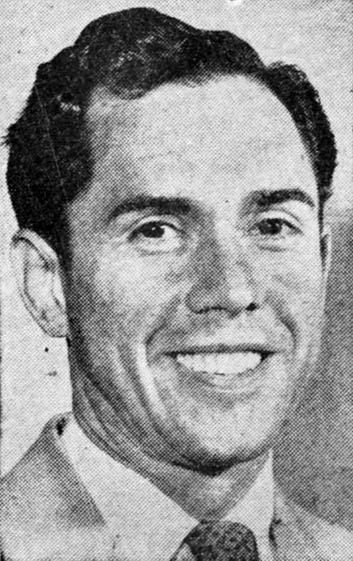 In May 1942 he was back in Montreal at the El Morocco with Frances Faye. In August 1942 Nick was in No, No, Nanette in a touring company that also visited St. Louis and Hartford. In this production he and Joan Rogers did a routine impersonating Fred Astaire and Ginger Rogers to music from their films. On the left you can see a picture of Nick from No, No, Nanette.
In May 1942 he was back in Montreal at the El Morocco with Frances Faye. In August 1942 Nick was in No, No, Nanette in a touring company that also visited St. Louis and Hartford. In this production he and Joan Rogers did a routine impersonating Fred Astaire and Ginger Rogers to music from their films. On the left you can see a picture of Nick from No, No, Nanette.
Later that year he enlisted in the Army, and he was honorably discharged seven months later. It looks like the army was not cut out for him or they didn't want him. His short time in the Army was reported on in the press, they were careful to note his discharge was honorable, but gave no reason for it. He had been assigned to the Signal Corps in Ft. Monmouth, New Jersey. Ft. Monmouth was huge, 2,000 officers and almost 20,000 enlisted men where trained there between 1942 and 1946. The base had a movie studio were they created training movies for the Army. Perhaps Nick was assigned to that unit. The newspapers reported that he was Master of Ceremonies for shows put on in the camp.
When Nick enlisted 2,000 men were arriving a month to be trained for the Signal Corps as communications specialists. The training program was four months and involved message center and messenger procedure, wire construction, and radio and wire communication. You had to have a high school degree to be accepted. In 1942 they accepted a large number of people who were unqualified for one reason or another and washed out of the program. There were a few administrative or training slots available, like those in the film studio. I figure Nick washed out after the four month training program. Of the approximately 25% who did not graduate, 11% were rejected because of academic deficiencies, 8% for lack of leadership. 2% because of lack of technical education or communications experience; and 4% for miscellaneous reasons, including lack of adaptability, summary dismissals, and dismissals for physical reasons or conduct unbecoming an officer candidate. Obviously for some reason they found him useless to the war effort and discharged him. It's funny, his enlistment papers read Occupation: Show Girl/Dancer! Fred Astaire had tried to enlist but he was turned down for medical reasons and because he had a family. Nick was single with no family. While he was in the service Nick wrote a march for the Signal Corps called "Get that Message Through". The news that Nick was out was in the column On Broadway on April 26, 1943. She reported the discharge was honorable and that Nick would be working in a defense plant. That wasn't true, he went right back to work as a dancer. A month later he was performing at the Hippodome in Baltimore.
There were other Broadway performers who enlisted in the Signal Corps during WWII. One of them was Gene Berg, a tap dancer and ice skater who was a friend of Nick's from Seattle. He was appearing in a Sonja Henie review on Broadway when war was declared. He knew he was going to get drafted so he enlisted in 1941. He was a buck private assigned to Company L of the Fifteenth Regiment Officers Candidate school as a company clerk. Bored, he would tap dance around the base listening to his portable radio. One day a soldier named Irving Lazar saw him dancing and asked him to be in a post show on the base. That show was attended by Irving Berlin, Josh Logan Ezra Stone and Robert Riley, all Broadway stars now in the military as officers. They were there scouting talent for Berlin's all army show This is the Army. Next day Nelson got orders to transfer to This is the Army Company where he joined a company of 365 actors, dancers, singers and technical crew. This is the Army appeared on Broadway for six months and then went on a world tour in July 1942. Is it possible Nick thought he could sign-up and get into the unit like Gene did - and it didn't happen so he figured out a way to get out? He enlisted in September 1942 a month before This is the Army started their national tour. He didn't go with them.
Nick gave a newspaper interview during the short time he was in the Army for the Ashford News which was a paper near Ft. Monmouth. It was January 1943 and he had finished basic training and was dancing for large crowds at the fort and other forts in the area. He also appeared at a Christmas party at a local High School that was attended by a group of British sailors. In the article Nick brags about knowing Sarah Churchill, his Hollywood days and the starts he worked with. He specially mentions Cary Grant, Eleanor Powell and Robert Taylor - but not Danny Kaye. Nick relates how he told the British sailors about this days in London during the first months of the war and how he experienced air raids and had "gone on with the show" during bombings. Nick was not in London during the war. He came back in February 1939 and didn't return. Why did Nick lie? Danny Kaye was becoming a huge star then (as Nick predicted), but Nick didn't mention him. Kaye knew when Nick returned to the USA. I think Nick was freaked out by the possibility he might have to stay in the Army in an administrative job. For some reason he could not get into the This is the Army Company. They already had more than enough actors and dancers enrolled Irving Berlin approved every addition to the company himself. He knew Nick from his work in Berlin's Louisiana Purchase musical and had also known his work on Broadway and in the movies. None of this could get Nick in. Somehow Nick got a discharge from the Army after the article came out. The details of Nick's army records are sealed now, since there are no living descendants we'll never know the exact circumstance of how he got out. Draft and enlistment interviews at the time were very tough, especially in New York. Nick's occupation and the fact he had never married must have raised eyebrows for his interviewer who would have asked standard questions to make sure Nick wasn't gay. If you were discovered to be gay your draft card was so noted. Employers could ask to see your draft card. Nobody wanted to get a deferment that labelled you as gay, so 99% of guys just lied. The questions were rather simple and it was easy to get coached on what to say by somebody who had been through it. Being married helped tremendously, but you could still be suspected of being gay and answer the questions in an equivocal way that would get you in trouble. Once you were in the army you would be dishonorably discharged if they found out you were gay and be labeled for life. You might be lucky and find somebody to discharge you who was understanding and supportive, especially if you were a celebrity. Ft. Monmouth was close to New York and many of the show people who enlisted went through there so they would have had lots of experience with guys in Nick's shoes. Getting a discharge for alcoholism was not an honorable one either. I can't imagine anyone in show business asking to see Nick's discharge papers after he left the service. Everyone would have read about Nick's discharge being honorable in Variety and that would have been enough for booking agents.
Nick toured the country with his act, performing in nightclubs and cabarets. For years one of Nick's routines was dance impressions, He used old shoes as props, each pair representing a dance artist. Through magic he would be transformed by each pair of shows into that dancer and he would perform in their style. He also did voices to mimic them. His parents had also been known for accents and impersonations. He was really good at it and continued to get praise for it right up until his last performance. It's possible these impersonations could distract attention from a decline in his technique - a decline which would have been natural - and unavoidable - as he got older.
In 1943 he appeared on a 30 minute KGU radio show, Walter O'Keefe's "Battle of the Sexes", along with two other men - one of them was Walter Long - and three famous women dancers, Maria Karnilova, Lucia Chase and Rosella Hightower of American Ballet Theater. The men were all tap dancers while the women were ballerinas.
There are three more records of Nick having been injured 'on the job'. He sprained his ankle which shut down production for a week of Kitty's Kisses on Broadway in 1928. The fact that he was not replaced shows how unique his style of dancing was - and he didn't have an understudy. Later it was reported he was hurt during the filming of Broadway Melody.
In the 1940's Nick was booked into clubs like the Lookout House outside Cincinatti just over the Kentucky state line. He had long bookings there and came back there several times. In 1948 he appeared there with Henry Busse and his Orchestra and June Taylor's dancers. Originally founded in the 1850's as Rush's Tavern, it had a high cupola on roof which was used as a lookout, especially during 20's prohibition. Enlarged in the 30's to Bill Hill's Lookout House to host dance bands and large gatherings, it was converted by Jimmy Brink in the 40's into a 'premier entertainment center' which also had an illegal gambling club in the back, controlled by midwestern crime organizations. It became a very luxurious establishment presenting top name entertainers and comedians/performers from New York and California - rivaling nearby Beverly Hills Country Club in Campbell County south of Newport. Over his career Nick had often worked in clubs associated with shady figures or criminal organizations, it was adjust a fact of the entertainment business since prohibition days. Nick was also booked several times at the Beverly Hills Club, once immediately after closing at the Lookout House. The Beverly Hills Country Club was another gambling establishment run by the mob and hired top entertainment from New York and Las Vegas. like Frank Sinatra and Dean Martin. The club is infamously remembered as the site of a horrible fire in 1977 when 168 people were killed.
Nick found himself touring the Midwest and Florida a lot. He performed in a Havana casino in January 1947. He built up fan bases in the cities he visited over and over again, like Pittsburgh were he came back to the Terrace Room several times.
Sometimes Nick appeared alone, sometimes with female dancers to accompany him. He appeared in a Benny Davis production at the Copacabana in Miami in 1947 followed by a month at Chez Paree in Chicago with Carmen Miranda. Mickey Rooney was a friend and asked Nick to dance with him at the Loews State Theater in Florida. He made it out to the Golden Gate Theater in San Francisco in October 1947 where he appeared with Hi, Lo, Jack and the Dame and Vivian Blaine. Hi, Lo, Jack and the Dame had also performed with Nick at Chez Paree in Chicago and the Terrace Club in Pittsburgh. The Golden Gate Theater was the last vaudeville theater in San Francisco it ended it's vaudeville shows in 1948. It was a prestigious venue in the city, in the same year Frank Sinatra and the Andrews Sisters appeared there.
Throughout his life Nick had the thin, muscular build of a professional dancer. Shaving off his mustache made him look more youthful.
Nick had a problem with drinking and this made it hard for him to get good jobs in his last years. A fellow dancer, Jacqueline Harvey, had a crush on him and even moved to Manhattan to be close to him. Her real name was Yvette Beaudoin and she had been born in Montreal. Yvette was 20 when she met Nick and she had been working in men's nightclubs in Canada before she moved to New York. She had a fondness for handsome older men who dressed well. Early on she had the reputation of a daddy-chaser, pursuing a number of guys without success in landing one.
Yvette worked in the Esquire Club in Montreal (with her parents approval). Later I will write more about Nick at the Esquire in 1949, which was one of his last significant jobs. The club was place where men could meet and pick-up beautiful young and available women. Recently the city had cracked down and closed all the brothels in Montreal. The Esquire Club - as a semi-legit business - stayed open. There were many of these clubs across Canada and the USA at the time. The cops in Montreal were closely watching the Esquire Club. Yvette's dad was a taxi cab driver and he came to pick her up from the club one night. The vice squad was convinced there was something fishy going on between this teenager and her 'daddy'. They didn't believe he was her real father and pursued them when they left the club. Yvette's dad, Jules, being a cab driver was able to ditch the cops who were on their tail.
Other members of Yvette's family were in the entertainment business, her parents at one point owned a restaurant that had live entertainment and dancing. She studied ballet in her youth and later in life saw herself as a ballerina rather than an exotic dancer. Her book, "Once Upon a Galaxy", can be found on Google here. Nick and Yvette (working under the name of Jacqueline Harvey) worked together at the Latin Quarter and she tried to keep his drinking under control. I wonder if she knew Meg Hartwig. Before a performance she would hunt for Nick in bars on Broadway, where all the bartenders knew him and his problem. Even at 44 (he was twice her age), she described him as tall, handsome and incredibly sexy. Despite her beauty and charm, Nick showed no sexual interest in her. They never even kissed. After a month of just talking and glasses of Dubonnet at the Mont Royal Hotel she moved back home to Long Island. The only reasonable explanation she could find was that drinking had destroyed his sex drive. She wrote that Nick got fired from jobs for his drinking. Yvette went on to become the mistress of a mysterious and famous singer named Juan ( I can't find his last name in her books for sure, is it Rojas?) and she followed him around the world for a number of years. She was still alive a couple of years ago, but I have had no success in locating her in California. She would be the last living person to have known Nick personally. I would love to talk to her - if I could only find her!
Nick must have been flattered that a young dancer was interested in him, even a female one. During his career Nick had a number of women partners he toured and danced with professionally. Nick might have entertained the idea that Jacqueline could be a potential touring partner. She showed a keen interest in Nick as a man and not just a fellow dancer in the entertainment business. One can imagine how Nick might have been horrified when he learned the extent and true nature of Jacqueline's interest in him, which developed into an obsession almost overnight. This was not a woman who would be satisfied in just being a beard in a sexless relationship with him. Nick must have learned over the years not to confide in anyone about who he really was. He never knew who he could trust and what was left of his career could be ruined overnight by rumors about his sexuality.
Besides the constant threat of being exposed as a gay man, drinking was a way of self-medicating himself for the pain and injuries he had sustained over the years.
Nick was not only gay dancer to have a problem with drinking, Lee Dixon's career was ruined by heaving drinking. Tall and blond, he was the original Will in Oklahoma and was a dancing heart-throb of the 1930's.
Most dancers, even male dancers, had retired by his age. Nick must have been forced to work because he needed the money, he couldn't retire. His tour schedule was back-to-back engagements criss-cross the country by train and car. He was working at the Chez Paree in Chicago, the Latin Quarter New York and in the Adirondacks in his last few months. He lived in the Markwell Hotel on West 49th Street in New York, but one could say he was living out of a trunk again, just like he did when he was a baby and touring with his parents. It was only ten years since his transatlantic success in London, New York and Hollywood. He had fallen from a great height. Even though he was still booking appearances the venues weren't so hot and the pay was next to nothing. Some of the top clubs would still book Nick based on his past reputation and their former success with him as a headliner. He was still a star in the dance world. What made it even tough on him was the clubs had high expectations for his performances and he still had loyal fans - especially in the Midwest. The success of any dancer is based on how effortless his performance appears and how well he entertains the paying audience. Nick was still getting great reviews, but every time he stepped on dance floor in a club he was one step closer to the looming end of his career. He would have been painfully aware of every routine and the difficulty of doing the steps that used to be so simple and effortless in appearance. His body couldn't do the things he used to. It was also a challenge to come up with new and modern dances, reinventing himself in the process. The tux - an updated one - was the only costume he packed for years. Nick still had the boyish looks and charming smile that the public had always won him fans and admirers. You could say he had a lot going for him at this point. Nick was still staying in fancy hotels and resorts on the road when the gig picked up the tab. Since he was working nightclubs where food was served he could often eat well and for free. Most clubs did not offer free drinks until AFTER a performance - for obvious reasons.
Nick must have felt very alone at this point in his life, everyone in his family was gone and he doesn't seem to have had any intimate friends. Did Nick try and reconnect with Danny Kaye, who was then experiencing fabulous success in Hollywood? A severe drinking problem would have made it tough to maintain relationships like that one. So - he was very fortunate at this stage in his career to meet June Taylor again and to be taken under her wing.
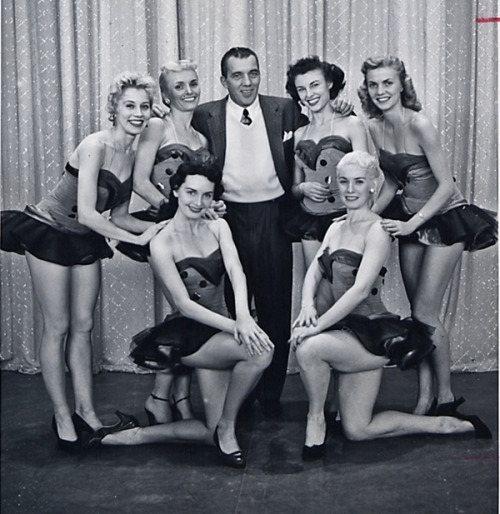 Nick appeared on TV in Ed Sullivan's Toast of the Town on September 12, 1948 with the June Taylor dancers. The review of the show I found just says he was great. Now I am looking for stills from the show or a video somewhere. In seems the 1948 Ed Sullivan TV shows are badly documented. The September 12, 1948 does not even have a list of the acts. Besides Nick it featured Luxor Gali-Gali, the magician, Leo Durocher, Myron Cohen, Sarah Vaughan and Pigmeat's company of five from the Apollo Theatre in Harlem, the Dennis Sisters and the Whirlaways roller-skating act. Ray Bloch and his orchestra backed up the show.
Nick appeared on TV in Ed Sullivan's Toast of the Town on September 12, 1948 with the June Taylor dancers. The review of the show I found just says he was great. Now I am looking for stills from the show or a video somewhere. In seems the 1948 Ed Sullivan TV shows are badly documented. The September 12, 1948 does not even have a list of the acts. Besides Nick it featured Luxor Gali-Gali, the magician, Leo Durocher, Myron Cohen, Sarah Vaughan and Pigmeat's company of five from the Apollo Theatre in Harlem, the Dennis Sisters and the Whirlaways roller-skating act. Ray Bloch and his orchestra backed up the show.
That's Ed and the June Taylor Dancers on the right. The review I read was critical of Ed Sullivan for turning the cameras on the audience at the end to point out the celebrities that were there. It took so long the end of the show was cut off and the final act was never seen. I understand Ed was not very popular in the first couple of years of his show. Viewers did not like him. Nick might had been hoping for a rebirth of his career on television, but it was not to be. The network forced Ed Sullivan to pay for some of the costs of the show. June Taylor wanted to have Nick back and add more men to the act. Because he was now footing the bill for the performers on his show, Sullivan cut all of the male dancers to save money, so Nick was out of a job. That must have been a surprise and a huge disappointment for him. The dancers were paid next to nothing, anyway.
In 1949 there was a major shift in musical entertainment to television. Many of the orchestras and acts that Nick used to tour with were now signing lucrative TV contracts. People were abandoning the clubs and staying home to watch TV. The June Taylor Dancers did a number of spots on Ed Sullivan and then moved to steady work on the new Jackie Gleason show. Nick knew Jackie from clubs they had performed in. The Henry Busse stopped touring and moved to television. Nick probably tried to get TV jobs and failed. June Taylor didn't invite him to move with them to the networks. Jackie Gleason doesn't seem to have been interested. Gleason didn't like male dancers and didn't want them on his show. I don't know if Nick did his own bookings but it must have been a tough job to keep him in steady work. Nick spent his last few months touring close to home.
In April 1949 Nick had a very successful back run at the Esquire Club in Montreal, which was held over. He seems to have been at the top of his craft, successfully performing dances which were difficult to do technically and were hard on a dancer's body. Nick's act consisted of a Bill Robertson (Bogangles) rhythm tap, a clog dance, a Hal Leroy soft shoe, Ray Bolger Wizard of Oz dances and finally an Irish jig. This was the same act he had been performing for years as a solo act. It was very popular and it must have given him great satisfaction as an artist that he could still dance at this level and be paid for it. Jacqueline Harvey says he was drinking heavily during this gig and was being fired from jobs. In the case of the Esquire he was never fired and had his engagement extended. Later Nick performed at the Orpheum and Vodvil at the Oriental Theater in New York as he had been doing for two years These are the last bookings I can find for him. Jacqueline Harvey followed him back to New York.
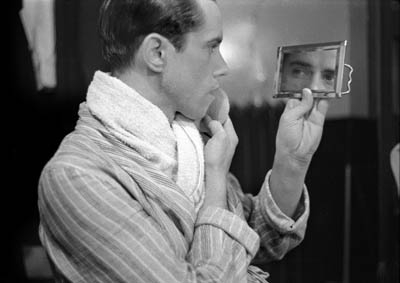 Nick was driving back from night club and vaudeville engagements in New England when he was in an auto accident at 236th Street and the Henry Hudson Parkway at 2AM on August 30, 1949. There had been a storm early in the morning. The other guy in the two car accident, Otto Bream Jr., survived with a broken leg. Nick died of head wounds in Jewish Memorial Hospital in New York City. There was a skull fracture. One can imagine the injuries you could receive in a car accident before seat belts were required. Jacqueline Harvey thought the accident was suicide. Without access to the accident report we'll never know if alcohol was involved. He didn't die in the wreck, he was in Jewish Hospital for a day or so and died there. Ed Sullivan, who knew Nick reported on his accident and hospitalization in critical condition oin his nation-wide newspaper column.
Nick was driving back from night club and vaudeville engagements in New England when he was in an auto accident at 236th Street and the Henry Hudson Parkway at 2AM on August 30, 1949. There had been a storm early in the morning. The other guy in the two car accident, Otto Bream Jr., survived with a broken leg. Nick died of head wounds in Jewish Memorial Hospital in New York City. There was a skull fracture. One can imagine the injuries you could receive in a car accident before seat belts were required. Jacqueline Harvey thought the accident was suicide. Without access to the accident report we'll never know if alcohol was involved. He didn't die in the wreck, he was in Jewish Hospital for a day or so and died there. Ed Sullivan, who knew Nick reported on his accident and hospitalization in critical condition oin his nation-wide newspaper column.
The funeral was held at Walter B. Cooke on West 72nd Street. Since Nick was an active member of the American Guild of Variety Artists they posted notice of the funeral in Variety and encouraged their members to attend.
It's ironic, Nick's first mention in Variety was an auto accident his mother and he had when in when he was a baby - and the last story of Nick is another accident. He was 43.
Nick had been living at the 50 room Markwell Hotel on West 49th Street before his death. All the rooms had private baths. The hotel was popular with New York vaudeville and theater people and was moderately priced. It was a big step down from the days when Nick lived in modern, expensive and swanky Manhattan hotels, like the Paramount.
He never married. I have not been able to find any survivors or descendants. He was buried in Cypress Hills Cemetery in Brooklyn New York. His grandfather, the famous minstrel, Ben Cotton, I mentioned earlier, is there along with Nick's grandmother, Nellie Cotton, his mother Idalene Cotton (died 1941) and his dad Nick Long Sr. (died 1926) Nick's older sister, Gladys Long Davis had died 8 years before him in 1941. Nick's grave is unmarked, there was no one to add his name to the tombstone after he died. That's a sad ending to his story!
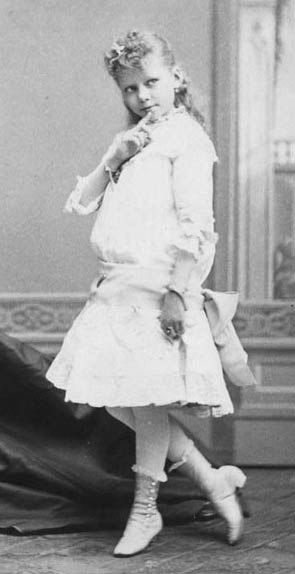 Idalene was a practitioner of Christian Science. (that's Idalene as a child on the right when she was performing with her father) She ordered the Cotton family cemetery plot at Cypress Hills, where she had the following quote from Mary Baker Eddy, founder of Christian Science, inscribed on the base of the family tombstone; "Therefore man is not material; he is spiritual."
Idalene was a practitioner of Christian Science. (that's Idalene as a child on the right when she was performing with her father) She ordered the Cotton family cemetery plot at Cypress Hills, where she had the following quote from Mary Baker Eddy, founder of Christian Science, inscribed on the base of the family tombstone; "Therefore man is not material; he is spiritual."
In researching Nick's timeline I used Ancestry's databases to start. I found the census data valuable and also used their immigration records to track Nick's multiple trips from the USA to England. I used the New York Times database and many articles relating to Nick and his parents, which was the best source for their careers and performances. You can search the Variety and other entertainment publication databases at a number of locations on the web. They are not complete.
I wonder how Nick would feel if he knew that his life story and his great talent was still being talked about 50 years after his death. In his last years he knew he was the last of the Cotton-Long theatrical dynasty and he must have realized that his performing career was drawing to a close. When he reflected on his career he probably had regrets or wondered why he had not had the success of Astaire. I hope he had someone he loved in his life and that he wasn't alone at the end of his life. So far I have found nothing about a lover or long-term partner. Maybe someday I will find a Hermes Pan for him, that would make me happy.
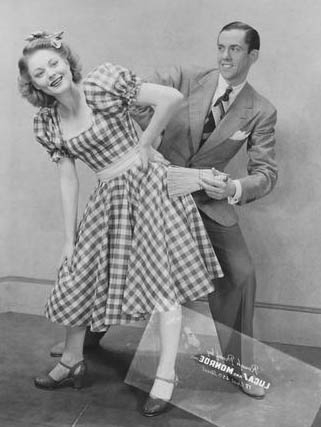
I wonder what happened to the scrapbooks and pictures of the family that were collected by Idalene over the years. They would have been a treasure trove documenting the lives of her family and the history of the American theater. When Nick died where did they end up? Did anyone appreciate their value at the time? Maybe somebody who reads this blog will know where to look.
There were two significant errors I found in the information published in the IMDB. Nick was born in 1904, not 1906 and they attribute a couple of performances of his father's to Nick Jr. The two pictures of Nick in his dressing room shown above are from the George Mann Archive.
This picture of the left is Nick from a song and dance routine in the musical Louisiana Purchase with April Ames. One reviewer called April Ames a "pert and pretty taptress, .. shapely, and expert at the tuneful taping, she delights to no end with her interpretive rhythm and rumba-conga routines". They are performing "You Can't Brush Me Off". Wow, I've heard it at this site - go listen - it's fun and upbeat. They had a second song and routine "I'd Love to be Shot from a Cannon with You". also great fun - that was cut before the show opened. You can learn more about the musical Louisiana Purchase there. You can also listen and purchase the songs on Amazon.
If you want to learn more about Ben Cotton and the Cotton family visit CottonHistories.com.
Finally, if you know anything about Nick Long and his family please contact me by phone or email.
Have any questions, stories or comments you want to post about Nick? Use our comments feature below.
Bob Atchison







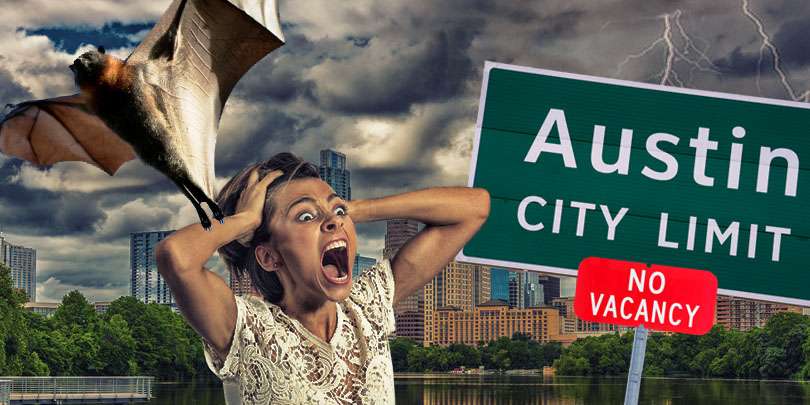
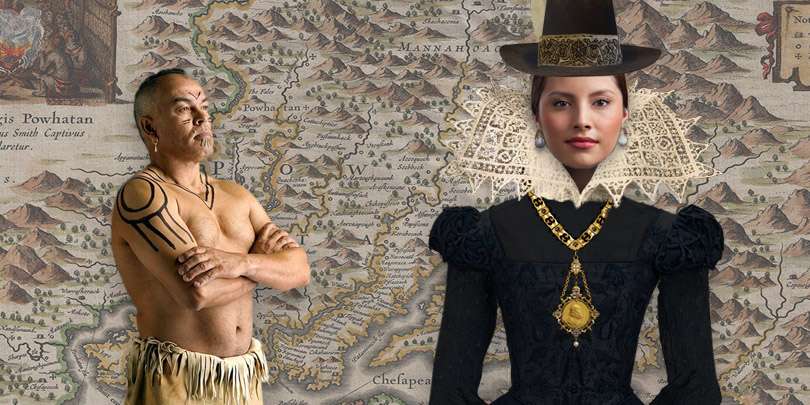







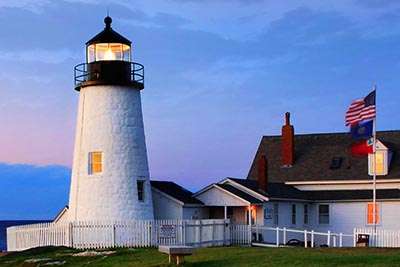
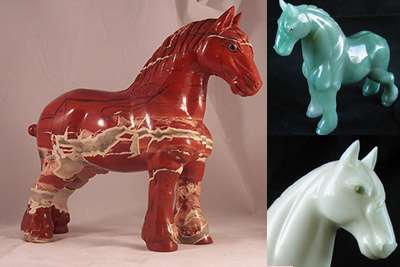









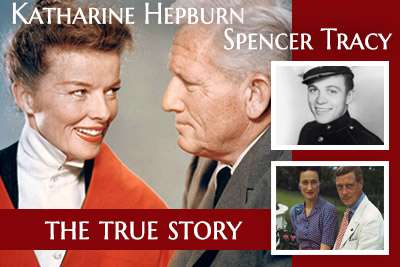
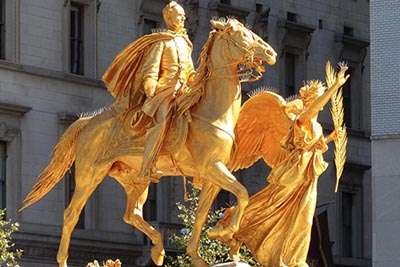
 New Home Builder Website Checklist
New Home Builder Website Checklist 












